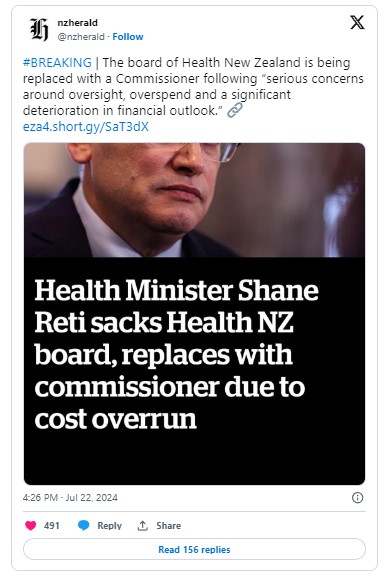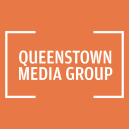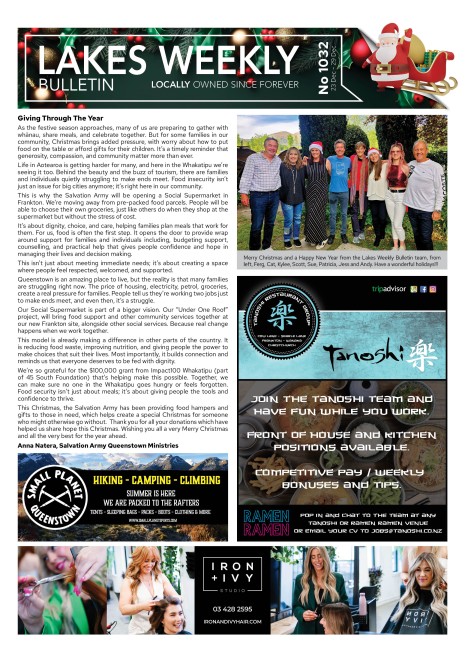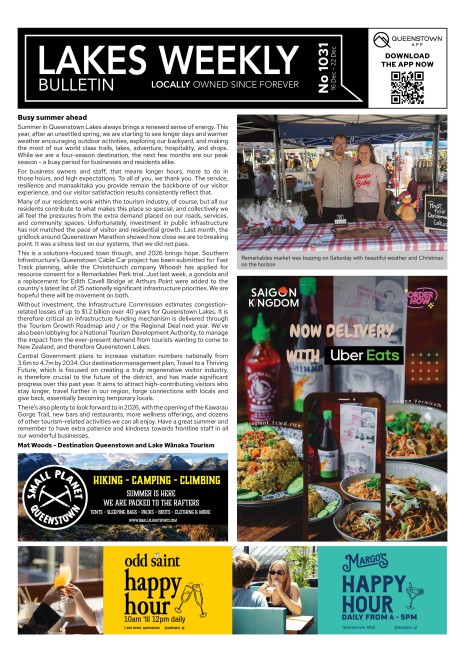NZ already spends less on health than Australia or Canada – we need proper funding, not ‘crisis’ management

Analysis: Academics Esther Willing, Jaime King, Paula Lorgelly, Peter Crampton, Robin Gauld and Tim Tenbensel writing for The Conversation NZ. *
We are being told the health system is in crisis, “on the brink of failure” – spending beyond its budget, waiting times getting longer, suffering from widespread staff shortages.
The government has responded by dismissing the board of Te Whatu Ora (Health NZ) and appointing Lester Levy as commissioner, with the task of reducing “overspending”. Levy himself has called the system “bloated” and said a “reset” is needed.
However, claims of overspending downplay the most significant external contributors to our stressed health system, while attempting to shift the focus internally. We are concerned the overspending narrative may be a precursor to doubt being cast on the viability of the publicly-funded system in general.
Many of the challenges faced by our health system are not unique to New Zealand. Global workforce shortages have been building since the 2000s, affecting most health systems.
COVID-19 exacerbated these trends. Many healthcare workers experienced burnout during the pandemic and left the health system. Many who remain are stressed and overworked.
Workforce pressures combine with a number of other factors: increased demand for health services, ageing populations (of patients and the health workforce), ever-growing treatment options and rising patient expectations, and an increasing prevalence of chronic health conditions needing ongoing, long-term care.
NZ underspends on health
The health systems of most high-income countries are under stress. But by far the biggest local factor contributing to New Zealand’s stressed health system is historical and current underfunding. Rather than overspending, it has been incredibly frugal for a long time.
Throughout the 2010s, just over 9% of the country’s GDP was spent on health, when most comparable countries were spending between 10% and 12%. According to OECD data, in 2020 New Zealand spent the equivalent of US$3,929 per capita on health – far less than Canada (US$6,215) and Australia (US$5,802).
That gap drives salary differences with comparable countries for health workers, exacerbating our workforce shortages as valuable trained staff leave for better pay elsewhere. While there is scope for productivity improvement in parts of the system, any such gains would be small compared to the cumulative extent of past underfunding.
Also important is the two-tiered nature of the New Zealand health system. The 1938 Social Security Act, which created the publicly-funded system, aimed to ensure health services would be free and accessible to all citizens. Now, however, primary health care is not affordable for around one in eight New Zealanders.
The problem goes back to the original compromise between the government and the medical profession. GPs retained the right to operate as private businesses, receiving government subsidies while also charging patients consultation fees. Doctors in public hospitals became salaried, but were allowed to operate a parallel private practice.
Consequently, better-off people could access health services more quickly in the private sector. No government since has been able to shift these arrangements, despite the considerable inequities of access they entail.
Would other funding models work?
For more than 80 years, the basic design of the publicly-funded health system has served us well, even with the two-tiered design flaws. Around 80% of the health system is funded publicly through taxation, a model we share with the UK, Spain and Scandinavian countries.
Given 37% of New Zealanders currently have private insurance, would a greater role for private funding reduce pressure on public funding? International experience tells us no.
The private insurance-based US health system is by far the most expensive in the world, soaking up nearly 18% of GDP. The prices paid by private insurers for health services have increased significantly faster than public parts of the US system.
There is also New Zealand evidence that private insurance can burden the public sector, with acute followup care sometimes required in public hospitals. Private insurers manage the pinch of rising healthcare costs by increasing premiums and tightening eligibility restrictions.
Health systems that rely on funding via private insurance are less accessible, less efficient, less equitable and generally have worse health outcomes. Put simply, market-based healthcare doesn’t deliver the expected benefits of markets, but does generate the expected downsides.
Another alternative to the tax-funded system is social insurance, where employers and employees pay into sickness funds, not unlike New Zealand’s Accident Compensation Corporation.
In countries with social insurance, such as Germany and the Netherlands, the provision of care is predominantly from non-government providers, rather than government-run hospitals. But research has shown there are higher cost pressures in social insurance systems because they are costlier to administer than tax-based systems.
In tax-based systems, rationing due to funding shortfalls is more visible in the form of waiting times and waiting lists. In private insurance-based systems, rationing is based on affordability and is far less visible.
Protecting access and fairness
Addressing the challenges within New Zealand’s health system requires adequate funding, and investment in the people who make up the system itself.
This includes the healthcare workers who take care of us, and the administrative and support staff who make that healthcare possible.
Short-term belt-tightening will most likely deepen the crisis. In the longer term, a viable publicly-funded system is more efficient and effective than the known alternatives.
This requires a policy commitment to actively address the many drivers of the crisis in ways that align with our values of universal access and fairness.
Meanwhile, we will need to have difficult conversations about how we address this underfunding, and how we train and support healthcare workers. Our publicly-funded health system is needed as much now as when it was first set up, to ensure all New Zealanders have access to healthcare when they need it.
*
Esther Willing
Associate Professor of Hauora Māori, University of Otago
Jaime King
Professor of Law, John and Marylyn Mayo Chair in Health Law, University of Auckland, Waipapa Taumata Rau
Paula Lorgelly
Professor of Health Economics, University of Auckland, Waipapa Taumata Rau
Peter Crampton
Professor of Public Health, University of Otago
Robin Gauld
Professor; Co-Director, Centre for Health Systems and Technology, University of Otago
Tim Tenbensel
Professor, Health Policy, University of Auckland, Waipapa Taumata Rau










